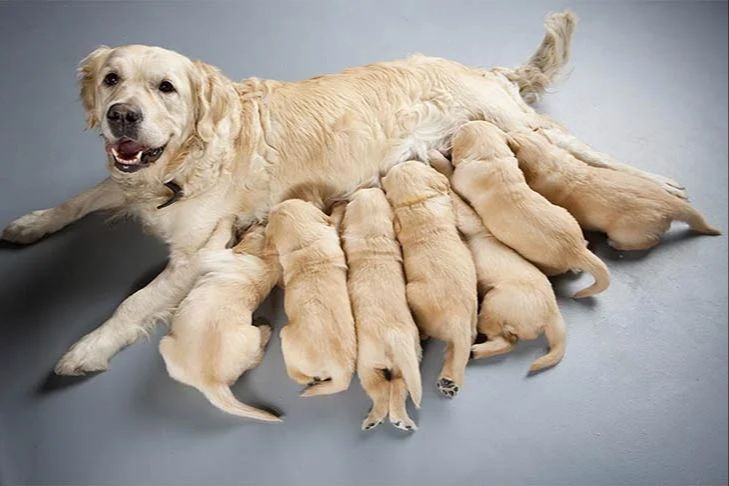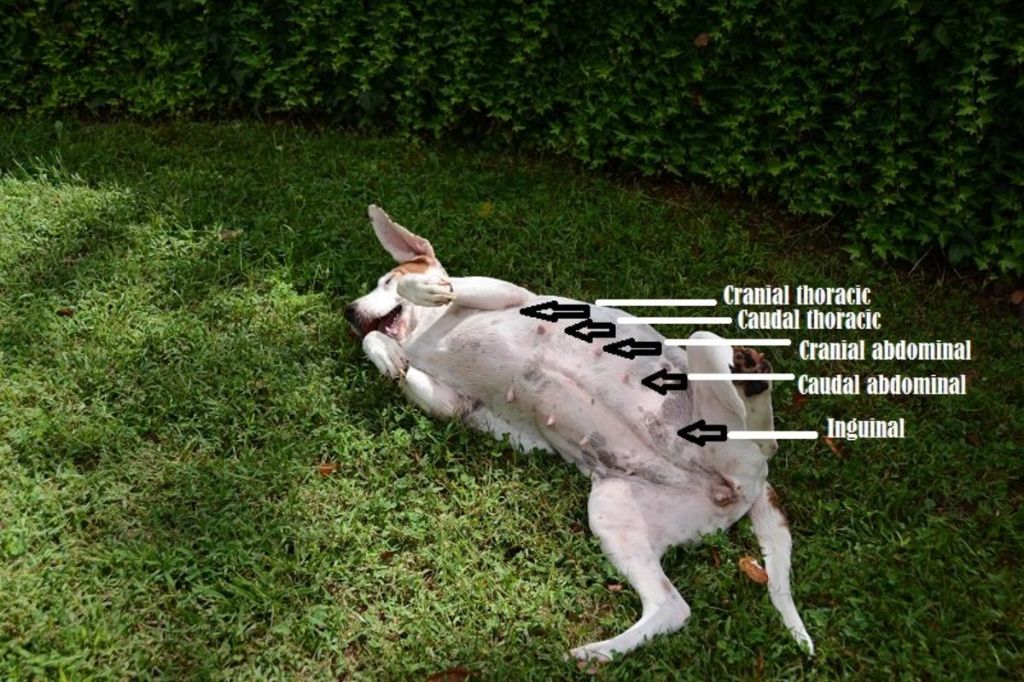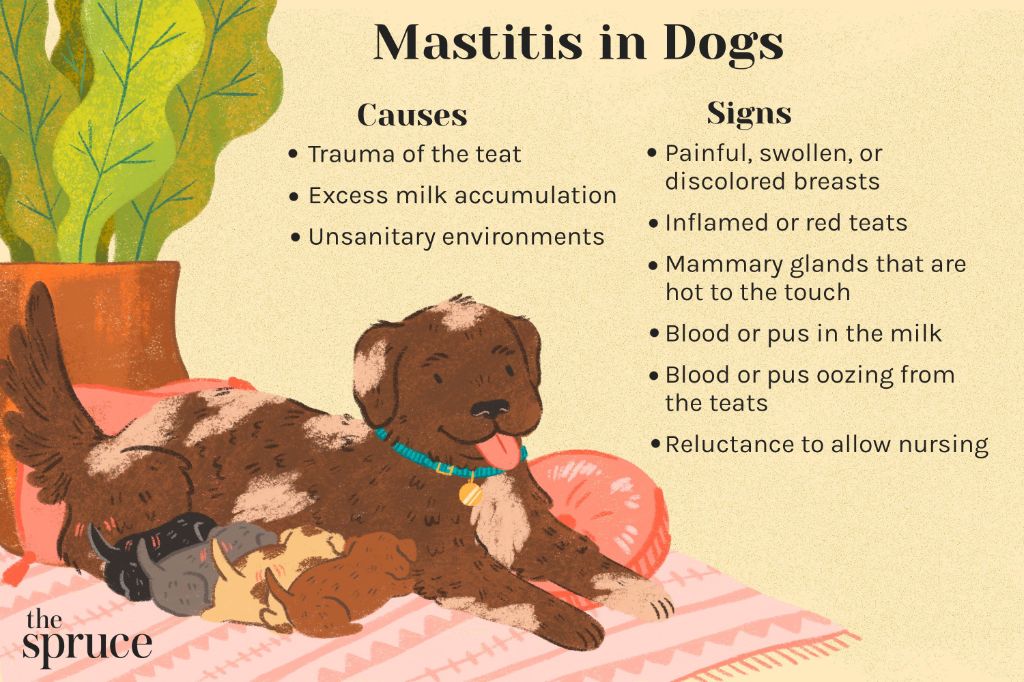Introduction
Nipple discharge in dogs can occur for many reasons. While it may seem alarming, it is often a normal part of dog health and development. However, sometimes nipple discharge can indicate an underlying medical issue that requires veterinary attention.
In intact female dogs, nipple discharge is common and expected when a dog goes into heat, is pregnant, or is pseudopregnant. Discharge can occur in male dogs as well. In dogs of both sexes, nipple discharge outside of pregnancy can also result from infections, medications, tumors, and other conditions affecting the mammary glands.
This article provides an overview of the most common causes of nipple discharge in dogs. Understanding the context around the discharge and your dog’s health history can help determine whether veterinary care is needed.
Normal Nipple Discharge
It’s normal for unspayed female dogs to have some nipple discharge when they are in heat or pregnant (Source). This discharge is usually clear or milky in color and consists of serous fluid produced by the mammary gland. When a female dog is in heat, hormones like estrogen cause the mammary glands to develop and secrete fluid. The discharge helps prepare the mammary glands for potential milk production if pregnancy occurs.
During pregnancy and after giving birth, it’s also normal for female dogs to produce a milky nipple discharge for nursing their puppies. As the puppies nurse, the stimulation triggers the mammary glands to produce milk. After weaning, as milk production stops, some discharge can continue for a while as the glands return to normal.
For an intact female dog, a small amount of nipple discharge isn’t usually a concern unless it’s bloody, purulent, or continues for more than a few days after estrus or nursing. Monitoring the color, consistency, and duration of discharge is recommended. Any abnormal discharge could indicate a health issue needing veterinary attention.
Milk
Nipple discharge in nursing mother dogs is normal and expected as they produce milk to feed their puppies. Lactation studies in dogs show that milk production begins around 2 weeks of gestation, with colostrum being produced initially. Milk production peaks at 2-4 weeks of lactation, with daily output reaching 1.3-5.9% of the mother dog’s body weight depending on litter size.

The hormones prolactin and oxytocin stimulate milk production and release. Suckling by the puppies is the primary trigger for these hormones. Milk is produced by the mammary glands and secreted through multiple nipples, usually 10-12 nipples arranged in two rows on the mother dog’s belly.
The milk provides essential nutrients, antibodies, and proteins to nourish the puppies as they grow. As long as the mother dog is nursing, it is normal for a clear or milky fluid to be discharged from the nipples. Once weaning is complete, milk production will stop and nipple discharge will cease.
Mammary Gland Tumor
One common cause of nipple discharge in female dogs is mammary gland tumors. Mammary gland tumors are abnormal growths of the breast tissue that can be either benign (non-cancerous) or malignant (cancerous). Malignant mammary tumors are the most common type of tumor found in unspayed female dogs, accounting for around 50% of all tumors in females.[1]
There are several types of malignant mammary tumors in dogs, including tubular carcinoma, inflammatory carcinoma, and solid carcinoma. Cancerous mammary tumors often start out small but grow quickly and can spread to other parts of the body.[2] They usually feel firm or hard compared to normal mammary tissue.
Dogs with mammary cancer commonly have nipple discharge from the affected glands. The discharge may be milky, bloody, serous (watery), or purulent (containing pus).[3] The presence of any abnormal nipple discharge in an intact female dog should prompt a veterinary visit to evaluate for mammary tumors.
Mastitis
Mastitis is the inflammation of a female dog’s mammary glands and is often caused by a bacterial infection. The most common bacteria to cause mastitis is Staphylococcus. Other bacteria such as Streptococcus, E. coli, and Pasteurella may also cause mastitis (Source 1).
Signs of mastitis include swollen, painful, and warm mammary glands. The mammary glands may appear red and the tissue surrounding the glands can also be affected. Mastitis can occur in mother dogs nursing puppies, during false pregnancy, or completely unrelated to reproduction. It is especially common during the two to three weeks after a dog gives birth.
Treatment of mastitis involves antibiotic therapy, warm compresses, anti-inflammatories, and discharge of any abscesses. Puppies may need to be weaned and milked out while the mother dog recovers. In severe cases, a mastectomy or removal of the mammary glands may be required. Prevention includes good hygiene, avoiding trauma to the mammary glands, and spaying dogs to avoid false pregnancies (Source 2).
Pseudopregnancy

Pseudopregnancy, also known as false pregnancy, is a hormonal condition where female dogs exhibit signs of pregnancy when they are not actually pregnant [1]. It occurs after estrus or heat cycles, triggered by the progesterone levels in an unbred dog mimicking the hormonal changes of a pregnant dog. According to [2], around 1 in 4 intact female dogs may be affected by pseudopregnancy.
Some common signs of pseudopregnancy in dogs include mammary gland enlargement, milk production, nesting behaviors, lethargy, vomiting, and abdominal distention that mimics a swollen pregnant belly. The dog may even gain some weight. These symptoms occur 2-12 weeks after the heat cycle ends and can last 2-3 weeks on average. Pseudopregnancy is not dangerous in itself, but dogs may need monitoring and treatment if symptoms like lethargy and vomiting are severe.
Treatment usually involves medications to interrupt the progesterone signals causing the false pregnancy signs. According to [3], a veterinarian may prescribe drugs like cabergoline or gonadotropin-releasing hormone analogues. Spaying is also an option to prevent recurrence. Providing good nutrition, gentle exercise, and mental stimulation can help support dogs through pseudopregnancy episodes.
Pyometra
Pyometra is a serious uterine infection that can cause abnormal nipple discharge in female dogs. According to Pyometra in Dogs: Symptoms and What to Do, pyometra typically causes a white, yellowish, or green vaginal discharge since pus builds up in the infected uterus. The pus cannot drain properly out of the body due to the closed cervix, so it sometimes leaks out through the nipples. Pyometra requires quick veterinary treatment since it can be fatal. Symptoms of pyometra include increased thirst/urination, lethargy, vomiting, and nipple discharge.
Medications

Some medications can cause nipple discharge as a side effect [1]. Certain drugs like oral contraceptives, antihypertensive drugs (such as methyldopa and reserpine), antipsychotics, antidepressants, and opioids can stimulate prolactin release and lead to a milky nipple discharge [3]. If a dog has recently started any new medications, it’s important to let your vet know as they may want to adjust dosages or change to an alternative medication.
Sometimes changing or discontinuing the medication may resolve nipple discharge that is being caused as a medication side effect. However, do not stop giving any prescription medications without first consulting with your veterinarian.
When to See the Vet
It’s recommended to get veterinary care if your dog has any abnormal nipple discharge, especially if the discharge is bloody, yellow, green, or smelly. These types of discharge can indicate an infection or tumor. You should also see the vet if your non-pregnant, non-nursing dog has swollen or enlarged nipples and any type of discharge coming from them.
According to VCA Animal Hospitals, it’s important to get prompt veterinary care for mastitis since it is a very painful condition that requires antibiotic treatment. Ignoring it can allow the infection to spread. Bring your dog in right away if her mammary glands are swollen, inflamed, or hot to the touch (VCA).

Schedule a vet visit if your spayed female dog has nipple discharge as this could signify a problem like a hormonal imbalance or mammary tumor. PDSA recommends getting lumps and bumps on the mammary glands checked out as soon as possible since catching mammary tumors early greatly improves the chances of successful treatment.
Conclusion
To recap, some of the main reasons for nipple discharge in dogs include pregnancy or pseudopregnancy, medications, mastitis, and mammary tumors. While some nipple discharge like milk is normal, abnormal discharge could signal a potentially serious health condition.
It’s important to monitor your dog’s symptoms and note any changes in the color, consistency, or amount of discharge. Persistent or bloody discharge especially warrants an immediate vet visit for proper diagnosis and treatment. Catching conditions like infections or cancer early vastly improves outcomes.
Consult your vet if you notice any bothersome nipple discharge in your dog. They can determine if it’s normal or requires medical intervention. With prompt veterinary attention for abnormal discharge, dogs can recover and continue to live happy, healthy lives.